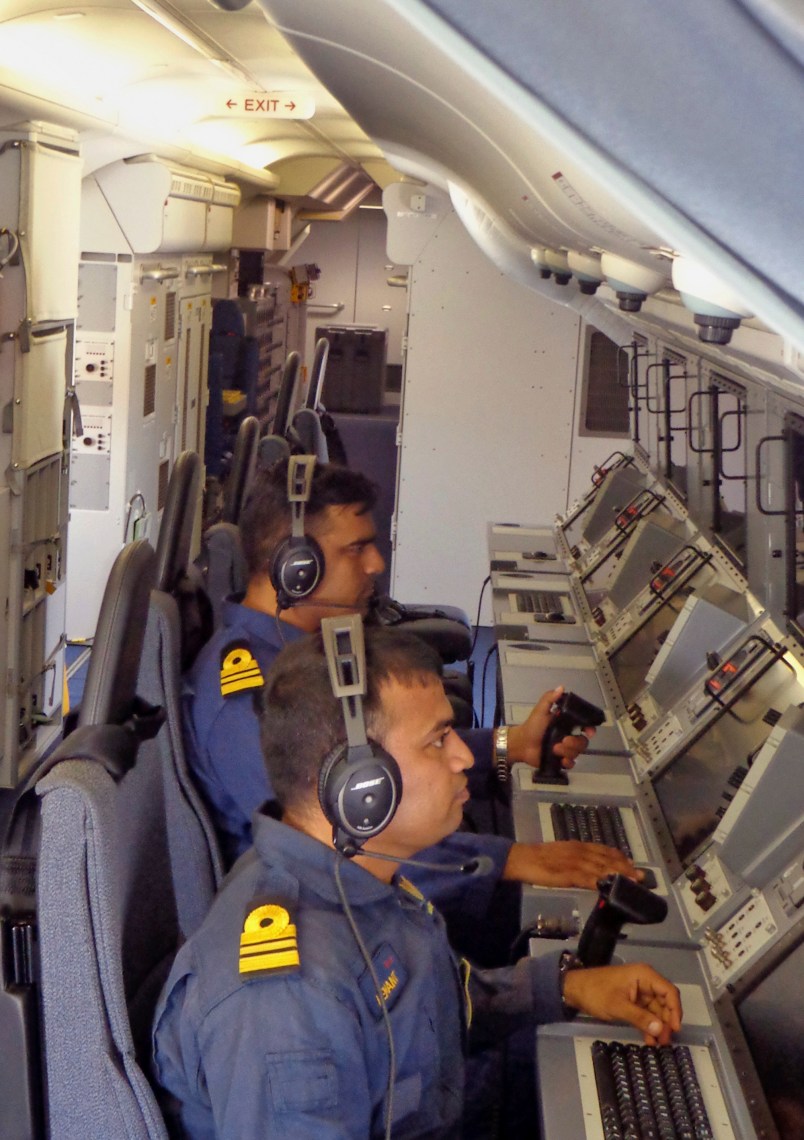KUALA LUMPUR, Malaysia (AP) — The final words from the missing Malaysian jetliner’s cockpit gave no indication anything was wrong even though one of the plane’s communications systems had already been disabled, officials said Sunday, adding to suspicions that one or both of the pilots were involved in the disappearance.
As authorities examined a flight simulator that was confiscated from the home of one of the pilots and dug through the background of all 239 people on board and the ground crew that serviced the plane, they also were grappling with the enormity of the search ahead of them, warning they needed more data to narrow down the hunt for the aircraft.
The Malaysia Airlines Boeing 777 took off from Kuala Lumpur at around 12:40 a.m. on March 8, headed to Beijing. On Saturday, Malaysia’s government confirmed that the plane was deliberately diverted and may have flown as far north as Central Asia, or south into the vast reaches of the Indian Ocean.
Authorities have said someone on board the plane first disabled one of its communications systems — the Aircraft and Communications Addressing and Reporting System, or ACARS — at 1:07 a.m. Around 14 minutes later, the transponder, which identifies the plane to commercial radar systems, was also shut down. The fact that they went dark separately is strong evidence that the plane’s disappearance was deliberate.
On Sunday, Malaysian Defense Minister Hishammuddin Hussein said at a news conference that that the final, reassuring words from the cockpit — “All right, good night” — were spoken to air traffic controllers after the ACARS system was shut down. Whoever spoke did not mention any trouble on board, seemingly misleading ground control.
Air force Maj. Gen. Affendi Buang told reporters he did not know whether it was the pilot or co-pilot who spoke to air traffic controllers.
Given the expanse of land and water that might need to be searched, the wreckage of the plane might take months — or longer — to find, or might never be located. Establishing what happened with any degree of certainty will likely need key information, including cockpit voice recordings, from the plane’s flight data recorders.
The search area now includes 11 countries the plane might have flown over, Hishammuddin said, adding that the number of countries involved in the operation had increased from 14 to 25.
“The search was already a highly complex, multinational effort. It has now become even more difficult,” he said.
The search effort initially focused on the relatively shallow waters of the South China Sea and the Strait of Malacca, where the plane was first thought to be. Hishammuddin said he had asked governments to hand over sensitive radar and satellite data to try and help get a better idea of the plane’s final movements.
“It is our hope with the new information, parties that can come forward and narrow the search to an area that is more feasible,” he said.
Malaysia is leading the multinational search for the plane, as well as the investigation into its disappearance.
In the United States, Dan Pfeiffer, senior adviser to President Barack Obama, told NBC’s “Meet the Press” that the FBI was supporting the criminal probe.
Rep. Peter King, who is chairman of the House Homeland Security subcommittee on counterterrorism and intelligence, said on ABC’s “This Week” that so far “there’s nothing out there indicating it’s terrorists.”
Investigators are trying to answer these questions: If the two pilots were involved in the disappearance, were they working together or alone, or with one or more of the passengers or crew? Did they fly the plane under duress or of their own volition? Did one or more of the passengers manage to break into the cockpit, or use the threat of violence to gain entry and then pilot the plane? And what possible motive could there be for flying off with the plane?
Malaysia’s police chief, Khalid Abu Bakar, said he requested countries with citizens on board the plane to investigate their background, no doubt looking for any ties to terrorist groups, aviation skills or evidence of prior contact with the pilots. He said that the intelligence agencies of some countries had already done this and found nothing suspicious, but that he was waiting for others to respond.
The government said police searched the homes of both pilots on Saturday, the first time they had done so since the plane went missing. Asked why it took them so long, Khalid said authorities “didn’t see the necessity in the early stages.”
Khalid said police confiscated the elaborate flight simulator that one of the pilots, Zaharie Ahmad Shah, had built in his home and reassembled it in their offices to study it for clues.
Zaharie, 53, who has three grown children and one grandchild, had previously posted photos online of the simulator, which was made with three large computer monitors and other accessories. Earlier this week, the head of Malaysia Airlines said this was not in itself cause for any suspicion.
Malaysian police are also investigating engineers and ground staff who may have had contact with the plane before it took off, Khalid said.
ACARS is used to send information about the plane’s engines and other parts to the airline. Even though it was disabled on Flight 370, it continued to send out faint hourly pulses that were recorded by a satellite. The last “ping” was sent out at 8:11 a.m. — 7 hours and 31 minutes after the plane took off. It placed the jet somewhere in a huge arc as far north as Kazakhstan in Central Asia or far into the southern Indian Ocean.
While many people believe the plane has crashed, there is a very small possibility it may have landed somewhere and be relatively intact. Affendi, the air force general, and Hishammuddin, the defense minister, said it was possible for the plane to “ping” when it was on the ground if its electrical systems were undamaged.
Australia said it was sending one of its two AP-3C Orion aircraft involved in the search to remote islands in the Indian Ocean at Malaysia’s request. The plane will search the north and west of the Cocos Islands, a remote Australian territory with an airstrip about 1,200 kilometers (745 miles) southwest of Indonesia, military chief Gen. David Hurley said.
Given that the northern route the plane may have taken would take it over countries with busy airspace, most experts say the person in control of the aircraft would more likely have chosen the southern route. The southern Indian Ocean is the world’s third-deepest and one of the most remote stretches of water in the world, with little radar coverage.
Malaysian officials and aviation experts said that whoever disabled the plane’s communication systems and then flew the jet must have had a high degree of technical knowledge and flying experience, putting one or both of the pilots high on the list of possible suspects.
Zaharie, the pilot, was a supporter of a Malaysian opposition political party that is locked in a bitter dispute with the government, according to postings on his Facebook page and a friend, Peter Chong, who is a party member.
Chong said that he last saw Zaharie a week before the pilot left on the flight for Beijing, and that they had agreed to meet on his return to organize a shopping trip for poor children.
“If I am on a flight, I would choose Captain Zaharie,” he said. “He is dedicated to his job, he is a professional and he loves flying.”
___
Associated Press writers Ian Mader and Eileen Ng in Kuala Lumpur and Kristen Gelineau in Sydney contributed to this report.
Copyright 2014 The Associated Press. All rights reserved. This material may not be published, broadcast, rewritten or redistributed.









